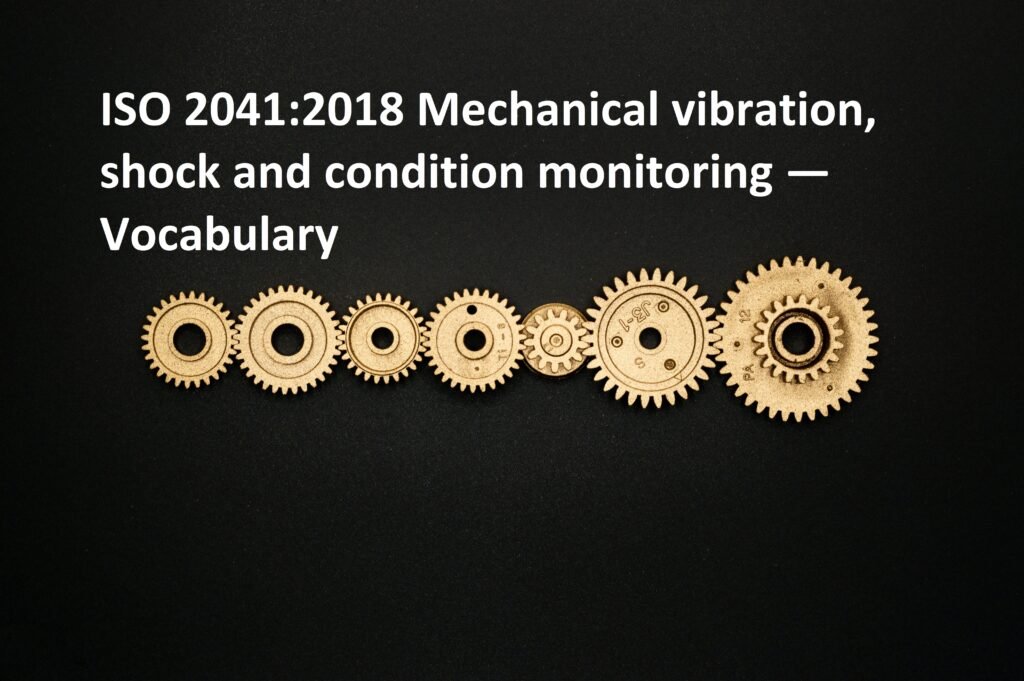What is ISO 2041:2018 Mechanical vibration, shock and condition monitoring — Vocabulary?
ISO 2041:2018 is a standard that defines terms and definitions related to mechanical vibration, shock, and condition monitoring. It provides a common vocabulary for use in the field of mechanical vibration, shock, and condition monitoring, and is applicable to all types of machinery, structures, and systems.
It covers a wide range of terms and definitions related to mechanical vibration, including:
Vibration: The standard defines various types of vibration. Such as free vibration, forced vibration, and resonance vibration.
Shock: The standard defines shock as a sudden and rapid motion or impact that results in a transient disturbance in a system or structure.
Condition monitoring: The standard defines condition monitoring as the process of measuring, analyzing, and interpreting the condition of a system or component to determine its health and detect potential problems.
Vibration measurement: The standard defines terms related to vibration measurement. Such as frequency, amplitude, and acceleration.
Vibration isolation: The standard defines terms related to vibration isolation. Such as natural frequency, damping ratio, and isolation efficiency.
Also, Vibration analysis: The standard defines terms related to vibration analysis. Such as frequency analysis, time waveform analysis, and phase analysis.
ISO 2041:2018 helps to promote clear communication and understanding among professionals in this field. It also helps to ensure consistency and accuracy in the interpretation of vibration and shock data.
Also, promotes the effective use of condition monitoring techniques to detect potential problems in machinery, structures, and systems.
Requirements of ISO 2041
ISO 2041:2018 Mechanical vibration, shock and condition monitoring — Vocabulary is a standard that defines terms and definitions related to mechanical vibration, shock, and condition monitoring. It does not provide specific requirements for these areas but rather establishes a common vocabulary to facilitate communication and understanding in the field.
The standard specifies the terms and definitions that are relevant to mechanical vibration, shock, and condition monitoring. Including terms related to the measurement, analysis, and interpretation of vibration and shock data. It covers a wide range of topics related to mechanical vibration. Such as:
· Types of vibration and shock
· Vibration and shock measurement
· Vibration and shock analysis
· And Vibration isolation
· Condition monitoring
The standard does not provide specific requirements for equipment or procedures used in mechanical vibration, shock, and condition monitoring. Instead, it provides a framework for the use of these terms and definitions in the development of related standards, guidelines, and best practices.
In summary, the requirements of this standard are focused on the definition and standardization of terms and definitions related to mechanical vibration, shock, and condition monitoring. Rather than specific requirements for equipment or procedures.
Benefits of ISO 2041
ISO 2041:2018 Mechanical vibration, shock and condition monitoring — Vocabulary provides several benefits to those involved in mechanical vibration, shock, and condition monitoring, including:
Standardized terminology: By providing a common vocabulary, the standard helps to eliminate confusion and miscommunication among professionals in this field. Thus, It promotes a clear and consistent understanding of key terms and definitions related to mechanical vibration, shock, and condition monitoring.
Improved collaboration: The standard facilitates collaboration among professionals involved in mechanical vibration, shock, and condition monitoring. By providing a common language that allows for effective communication and coordination. This helps to ensure that everyone involved in these areas is working towards the same goals and objectives.
Enhanced quality of data: Standardized terminology and definitions can help to ensure that data related to mechanical vibration, shock, and condition monitoring is accurate, consistent, and reliable. So, This, in turn, can lead to better decision-making and more effective maintenance practices.
Improved safety: Standardized terminology and definitions can help to improve safety in mechanical vibration, shock, and condition monitoring. By ensuring that everyone involved understands the risks and hazards associated with these areas. This can lead to better safety protocols and practices that help to minimize the risk of injury or damage to equipment.
Finally, Increased efficiency: Standardized terminology and definitions can help to improve efficiency in mechanical vibration, shock, and condition monitoring, by reducing the time and resources required to communicate and coordinate activities. This can help to streamline processes and improve overall productivity.
Pacific Certifications is accredited by ABIS, If you need more support with ISO 2041, please contact us at +91-8595603096 or support@pacificcert.com
Read About : ISO 2040:1972










